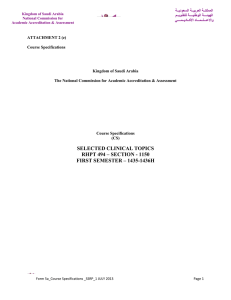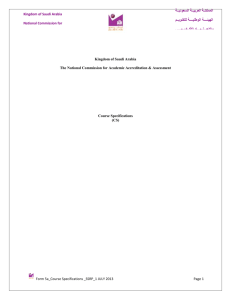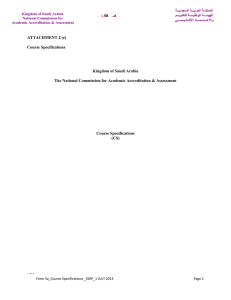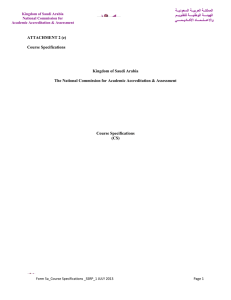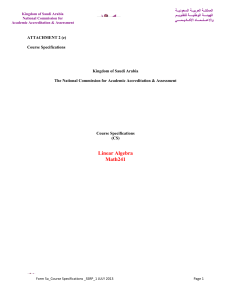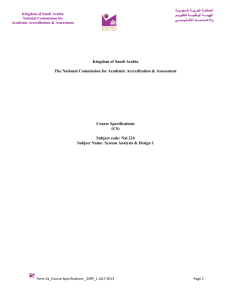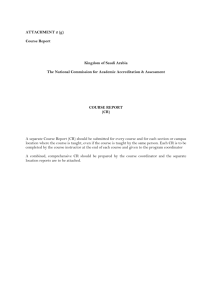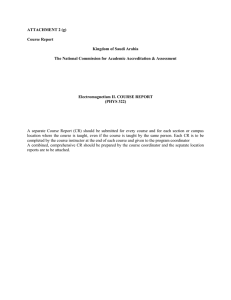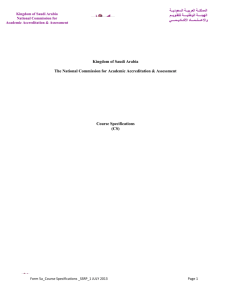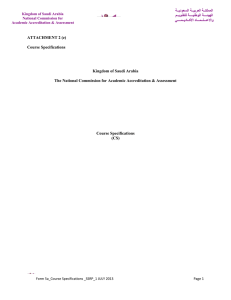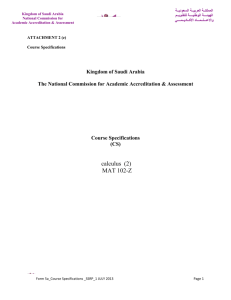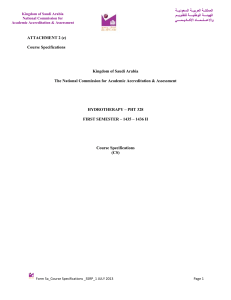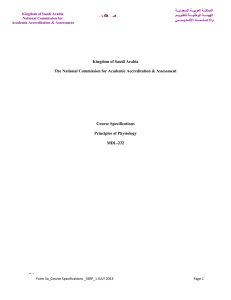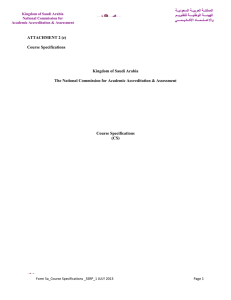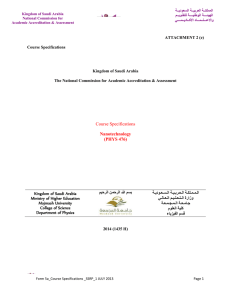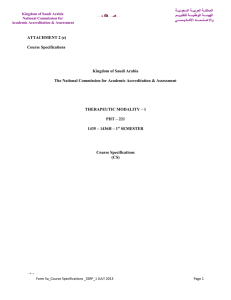Electric Machines
advertisement
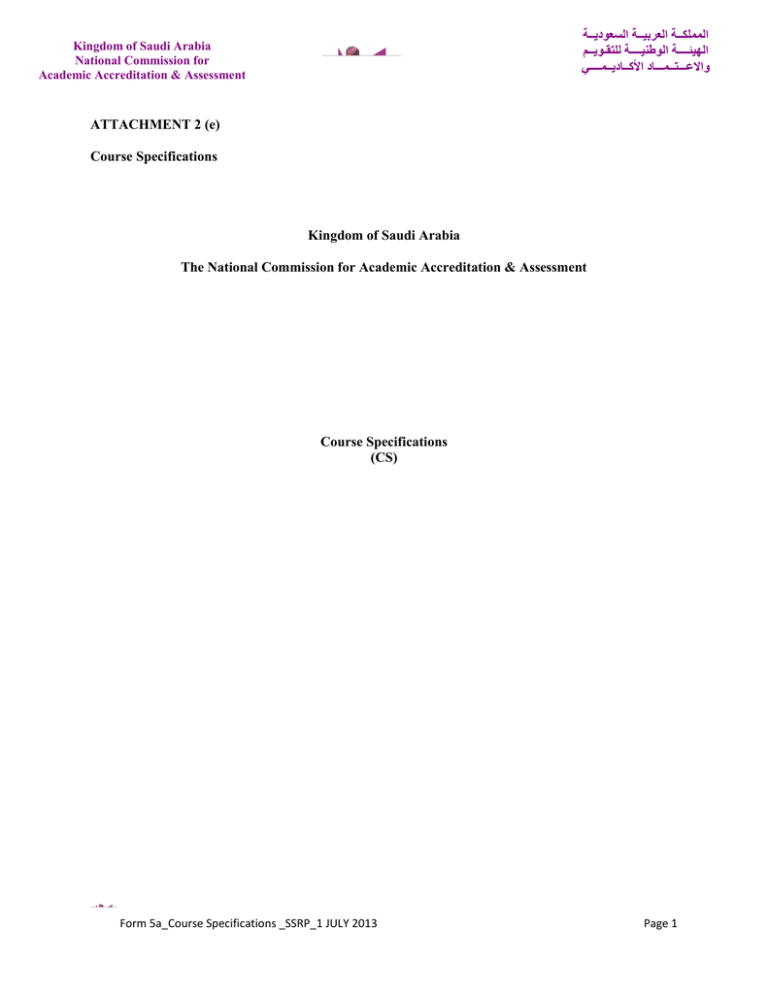
المملكــة العربيــة السعوديــة الهيئــــة الوطنيــــة للتقـويــم واالعـــتــمـــاد األكــاديــمــــي Kingdom of Saudi Arabia National Commission for Academic Accreditation & Assessment ATTACHMENT 2 (e) Course Specifications Kingdom of Saudi Arabia The National Commission for Academic Accreditation & Assessment Course Specifications (CS) Form 5a_Course Specifications _SSRP_1 JULY 2013 Page 1 المملكــة العربيــة السعوديــة الهيئــــة الوطنيــــة للتقـويــم واالعـــتــمـــاد األكــاديــمــــي Kingdom of Saudi Arabia National Commission for Academic Accreditation & Assessment Course Specifications Institution Majmaah University Date of Report 3-12-2014 College/Department College of Engineering Electrical Eng. Department A. Course Identification and General Information 1. Course title and code: Principles of Electric Machines EE288 2. Credit hours 3 3. Program(s) in which the course is offered. (If general elective available in many programs indicate this rather than list programs) Electrical Engineering Program 4. Name of faculty member responsible for the course Dr. Ahmed Galal Abokhalil 5. Level/year at which this course is offered Level 6 / year 3 6. Pre-requisites for this course (if any) EE 202 (Electric Circuit Analysis) 7. Co-requisites for this course (if any) 8. Location if not on main campus 9. Mode of Instruction (mark all that apply) a. Traditional classroom What percentage? 100 % b. Blended (traditional and online) What percentage? c. e-learning What percentage? d. Correspondence What percentage? f. Other What percentage? Comments: Form 5a_Course Specifications _SSRP_1 JULY 2013 Page 2 Kingdom of Saudi Arabia National Commission for Academic Accreditation & Assessment Form 5a_Course Specifications _SSRP_1 JULY 2013 المملكــة العربيــة السعوديــة الهيئــــة الوطنيــــة للتقـويــم واالعـــتــمـــاد األكــاديــمــــي Page 3 المملكــة العربيــة السعوديــة الهيئــــة الوطنيــــة للتقـويــم واالعـــتــمـــاد األكــاديــمــــي Kingdom of Saudi Arabia National Commission for Academic Accreditation & Assessment B Objectives 1. What is the main purpose for this course? By the end of the course, student should: 1- Understand the construction, connections, principle of operation of single-phase, three-phase and autotransformers. 2- - Understand the Equivalent circuits representing the transformers. 3- - Understand how to calculate the performance characteristics (voltage regulation and efficiency) of the transformers. 4- Understand the fundamentals of the ac machines such as the concept of the rotating flux, the induced voltage and torque. 5- Understand the construction, principle of operation, modeling of the synchronous generator. 6- Understand how to calculate the voltage regulation of the alternator using the phasor diagram or the complex numbers 7- Understand the power-delta relation and how to determine the steady state stability of the alternator. 2. Briefly describe any plans for developing and improving the course that are being implemented. (e.g. increased use of IT or web based reference material, changes in content as a result of new research in the field) 1- Apply modern techniques and tools to simulate electrical machines systems. 2- Use software such as matlab and pscad to analyze the performance of electric machines. C. Course Description (Note: General description in the form to be used for the Bulletin or handbook should be attached) 1. Topics to be Covered List of Topics The construction, connections, principle of operation of single-phase, three-phase and autotransformers The performance characteristics (voltage regulation and efficiency) of the transformers The fundamentals of the ac machines such as the concept of the rotating flux, the induced voltage and torque. The construction, connections, principle of operation of single-phase, three-phase and autotransformers The construction, principle of operation, modeling of the synchronous generator. Calculation the voltage regulation of the alternator using the phasor diagram or the complex numbers. The construction and principle of operation of the induction motor. Induction motor starting and speed control. Form 5a_Course Specifications _SSRP_1 JULY 2013 No. of Weeks 1, 2 Contact Hours 6 3, 4 6 5, 6 6 7, 8 6 9, 10 6 11, 12 6 13 , 14 15 6 3 Page 4 المملكــة العربيــة السعوديــة الهيئــــة الوطنيــــة للتقـويــم واالعـــتــمـــاد األكــاديــمــــي Kingdom of Saudi Arabia National Commission for Academic Accreditation & Assessment 2. Course components (total contact hours and credits per semester): Lecture Tutorial Laboratory Practical Other: Total Contact Hours 45 15 - - - 60 Credit 3 - - - - 3 3. Additional private study/learning hours expected for students per week. 4. Course Learning Outcomes in NQF Domains of Learning and Alignment with Assessment Methods and Teaching Strategy Course Learning Outcomes, Assessment Methods, and Teaching Strategy work together and are aligned. They are joined together as one, coherent, unity that collectively articulate a consistent agreement between student learning, assessment, and teaching. The National Qualification Framework provides five learning domains. Course learning outcomes are required. Normally a course has should not exceed eight learning outcomes which align with one or more of the five learning domains. Some courses have one or more program learning outcomes integrated into the course learning outcomes to demonstrate program learning outcome alignment. The program learning outcome matrix map identifies which program learning outcomes are incorporated into specific courses. On the table below are the five NQF Learning Domains, numbered in the left column. First, insert the suitable and measurable course learning outcomes required in the appropriate learning domains (see suggestions below the table). Second, insert supporting teaching strategies that fit and align with the assessment methods and intended learning outcomes. Third, insert appropriate assessment methods that accurately measure and evaluate the learning outcome. Each course learning outcomes, assessment method, and teaching strategy ought to reasonably fit and flow together as an integrated learning and teaching process. Fourth, if any program learning outcomes are included in the course learning outcomes, place the @ symbol next to it. Every course is not required to include learning outcomes from each domain. Form 5a_Course Specifications _SSRP_1 JULY 2013 Page 5 المملكــة العربيــة السعوديــة الهيئــــة الوطنيــــة للتقـويــم واالعـــتــمـــاد األكــاديــمــــي Kingdom of Saudi Arabia National Commission for Academic Accreditation & Assessment 1.0 NQF Learning Domains And Course Learning Outcomes Knowledge 1.1 1.2 2.0 A knowledge of contemporary issues. 2.1 An ability to design and conduct experiments, as well as to analyze and interpret data 2.2 3.0 3.1 3.2 4.0 4.1 4.2 5.0 Course Teaching Strategies Course Assessment Methods Lectures and surveys Exams, quizes and reports Lectures and Tutorial Reports and presentations Lectures and Tutorial Reports Cognitive Skills Interpersonal Skills & Responsibility An understanding of professional and ethical responsibility Communication, Information Technology, Numerical An ability to apply knowledge of mathematics, science, and engineering The ability to utilize statistics/probability, transform methods, discrete mathematics, or applied differential equations in support of electrical systems. Psychomotor Lectures and Tutorial Exams and quizes Lectures and Tutorial Exams, quizes and reports 5.1 5.2 Suggested Guidelines for Learning Outcome Verb, Assessment, and Teaching NQF Learning Domains Suggested Verbs Knowledge Cognitive Skills list, name, record, define, label, outline, state, describe, recall, memorize, reproduce, recognize, record, tell, write estimate, explain, summarize, write, compare, contrast, diagram, subdivide, differentiate, criticize, calculate, analyze, compose, develop, create, prepare, reconstruct, reorganize, summarize, explain, predict, justify, rate, evaluate, plan, design, measure, judge, justify, interpret, appraise Interpersonal Skills & Responsibility demonstrate, judge, choose, illustrate, modify, show, use, appraise, evaluate, justify, analyze, question, and write Communication, Information Technology, Numerical demonstrate, calculate, illustrate, interpret, research, question, operate, appraise, evaluate, assess, and criticize Form 5a_Course Specifications _SSRP_1 JULY 2013 Page 6 المملكــة العربيــة السعوديــة الهيئــــة الوطنيــــة للتقـويــم واالعـــتــمـــاد األكــاديــمــــي Kingdom of Saudi Arabia National Commission for Academic Accreditation & Assessment Psychomotor demonstrate, show, illustrate, perform, dramatize, employ, manipulate, operate, prepare, produce, draw, diagram, examine, construct, assemble, experiment, and reconstruct Form 5a_Course Specifications _SSRP_1 JULY 2013 Page 7 المملكــة العربيــة السعوديــة الهيئــــة الوطنيــــة للتقـويــم واالعـــتــمـــاد األكــاديــمــــي Kingdom of Saudi Arabia National Commission for Academic Accreditation & Assessment Suggested verbs not to use when writing measurable and assessable learning outcomes are as follows: Consider Maintain Maximize Reflect Continue Examine Review Ensure Strengthen Explore Enlarge Encourage Understand Deepen Some of these verbs can be used if tied to specific actions or quantification. Suggested assessment methods and teaching strategies are: According to research and best practices, multiple and continuous assessment methods are required to verify student learning. Current trends incorporate a wide range of rubric assessment tools; including web-based student performance systems that apply rubrics, benchmarks, KPIs, and analysis. Rubrics are especially helpful for qualitative evaluation. Differentiated assessment strategies include: exams, portfolios, long and short essays, log books, analytical reports, individual and group presentations, posters, journals, case studies, lab manuals, video analysis, group reports, lab reports, debates, speeches, learning logs, peer evaluations, self-evaluations, videos, graphs, dramatic performances, tables, demonstrations, graphic organizers, discussion forums, interviews, learning contracts, antidotal notes, artwork, KWL charts, and concept mapping. Differentiated teaching strategies should be selected to align with the curriculum taught, the needs of students, and the intended learning outcomes. Teaching methods include: lecture, debate, small group work, whole group and small group discussion, research activities, lab demonstrations, projects, debates, role playing, case studies, guest speakers, memorization, humor, individual presentation, brainstorming, and a wide variety of hands-on student learning activities. 5. Schedule of Assessment Tasks for Students During the Semester Assessment task (e.g. essay, test, group project, examination, speech, oral presentation, etc.) Week Due Proportion of Total Assessment First Midterm Exam 7 20 2 Second Midterm Exam 12 20 3 Project 10 10 4 Quiz and homeworks - 10 5 Final Exam 16 40 Form 5a_Course Specifications _SSRP_1 JULY 2013 Page 8 Kingdom of Saudi Arabia National Commission for Academic Accreditation & Assessment المملكــة العربيــة السعوديــة الهيئــــة الوطنيــــة للتقـويــم واالعـــتــمـــاد األكــاديــمــــي D. Student Academic Counseling and Support 1. Arrangements for availability of faculty and teaching staff for individual student consultations and academic advice. (include amount of time teaching staff are expected to be available each week) - The office hours for this course is 2 hours, in which the students can ask and discuss the topics and details they haven't understand in the lecture and tutorial main time. These hours can be arranged according to the student needs. E. Learning Resources 1. List Required Textbooks S. J. Chapman, “Electric Machinery Fundamentals”, McGraw Hill. 2. List Essential References Materials (Journals, Reports, etc.) SARMA, "Electric Machines-steady state theory and dynamic performance" 3. List Recommended Textbooks and Reference Material (Journals, Reports, etc) Electric Machinery , A. E. Fitzgerald, Charles Kingsley Jr., and Stephen Umans, McGraw Hill 4. List Electronic Materials (eg. Web Sites, Social Media, Blackboard, etc.) 5. Other learning material such as computer-based programs/CD, professional standards or regulations and software. F. Facilities Required Indicate requirements for the course including size of classrooms and laboratories (i.e. number of seats in classrooms and laboratories, extent of computer access etc.) 1. Accommodation (Classrooms, laboratories, demonstration rooms/labs, etc.) - Lecture rooms Form 5a_Course Specifications _SSRP_1 JULY 2013 Page 9 المملكــة العربيــة السعوديــة الهيئــــة الوطنيــــة للتقـويــم واالعـــتــمـــاد األكــاديــمــــي Kingdom of Saudi Arabia National Commission for Academic Accreditation & Assessment 2. Computing resources (AV, data show, Smart Board, software, etc.) 3. Other resources (specify, e.g. if specific laboratory equipment is required, list requirements or attach list) - Internet - Computers - Data show G Course Evaluation and Improvement Processes 1 Strategies for Obtaining Student Feedback on Effectiveness of Teaching - Student evaluation surveys 2 Other Strategies for Evaluation of Teaching by the Program/Department Instructor - Direct discussion with students to get their opinion about the course work. 3 Processes for Improvement of Teaching - Attending Workshops and training - Providing recent books in the electric machines field. 4. Processes for Verifying Standards of Student Achievement (e.g. check marking by an independent member teaching staff of a sample of student work, periodic exchange and remarking of tests or a sample of assignments with staff at another institution) - Invite and external professors in the field of electric machines to check the course work, reports, exams and project. Questionnaires to the stakeholders asking them about the graduated students' knowledge and understanding of electrical machines. Every year questionnaire – through COE - and quality assurance unit. Random rechecking of exams. 5 Describe the planning arrangements for periodically reviewing course effectiveness and planning for Form 5a_Course Specifications _SSRP_1 JULY 2013 Page 10 المملكــة العربيــة السعوديــة الهيئــــة الوطنيــــة للتقـويــم واالعـــتــمـــاد األكــاديــمــــي Kingdom of Saudi Arabia National Commission for Academic Accreditation & Assessment improvement. - Planned reviews - Following up students during the tutorial, lectures and discussion. Faculty or Teaching Staff: _ Dr. Ahmed Galal Abokhalil_______________________ Signature: _______________________________ Date Report Completed: Dec. 15 2014 Received by: _____________________________ Dean/Department Head Signature: _______________________________ Date: _______________ Form 5a_Course Specifications _SSRP_1 JULY 2013 Page 11
